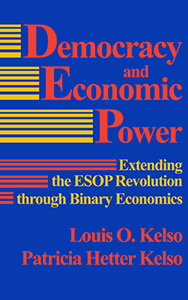by Louis O. Kelso and Patricia Hetter Kelso
Now that the Marxist-Leninist economies have failed in practice, the Soviet Union, Poland, Hungary, Czechoslovakia and the other Eastern European nations are resigning themselves to the Western-style market economy as the only viable alternative.
To Marxian-molded sensibilities, of course, this decision is the economic equivalent of re-enthroning the czars. The West, however, sees it as the ultimate confirmation of a system that the Marxist-Leninists vowed to destroy — and for the better part of this century, did their best to destroy. Magnanimous as usual in victory, our side is dispatching cadres of well-meaning free market missionaries — bankers, economists, accountants, lawyers, marketers, stockbrokers, communicators and other presumably indispensable professional talents — to fill the ideological and institutional void before anarchy rushes in. President Bush has even proposed that the United States formalize this redemptive mission by organizing task forces to tutor the fallen Marxists in free market theory and discipline.
But the Western market economy, however enviable it may seem to those still mired in varying stages of pre-industrial poverty or post-industrial socialist poverty, more closely resembles in several fundamental respects the ship the socialists are trying to jump rather than the one they are sighting to board. Private property is as indispensable to the free market as it is to political liberty.
Although ideologically committed to the institution of private property, Western industrial economies, like their socialist counterparts, rely on ever higher levels of income redistribution to stave off market collapse. The world regards the United States, for example, as capitalism’s flagship. But more than half of federal, state and local taxes — collected from those who produce higher incomes (mostly through their capital) — are redistributed in the form of welfare payments, open or disguised, to those who earn low incomes or none.
In other words, the communist principle of distribution, “to each according to his need,” is also an operational expedient of the Western-style free market. Ownership of capital, private in theory and on paper, is, in fact, socialized through coerced redistribution. In economies like the United States, where redistribution depends heavily on taxation, ever larger deficits make up the shortfall between income and expenditures.
Both market and socialist economies have exploited the Cold War — “communist threat” — to justify their massive redistributive spending.
Both the socialist and the Western free market models are dominated by monopolies. Both are committed to the same economic goal, i.e., full employment, with its social end product, proletarianization. What is a proletarian, after all, but an individual who owns no capital and thus is doomed to total economic dependence on labor or welfare? That description covers most of the citizens of Western industrial democracies, including the United States. Theoretically everyone may own capital; in reality, ownership is concentrated at the pinnacle.
Both the socialized economy and the Western market economy produce a high standard of living only for their respective elites — nomenklatura there, plutocracy here.
In both economies, poverty is endemic, ineradicable and spreading.
The U.S. budget deficit is itself an important measure of the economy’s failure to operate on current account. The free market is an input-outtake system. Its logic is simply double-entry bookkeeping. Productive input on one side delivers income outtake on the other, with the “invisible hand” being the private property mechanism that competitively evaluates individually owned capital and labor, keeping productive input and distributive outtake in balance. A successful market economy has no permanent deficits, either budget or trade.
Why, then, does the U.S. economy have perpetual and ever-rising budget deficits? Because the government must borrow money to support redistribution. Why redistribution? Because a majority of the people, as producers, cannot, through their labor alone, even when wages and salaries are coercively and progressively inflated, earn enough income to buy the goods and services primarily produced by capital that they do not own.
In other words, people are not personally equipped by ownership with enough productive power to enjoy the fruits of the Industrial Revolution even at its present stage. As technological change progresses, the gulf between production and market-supported consumption (as distinguished from consumption supported by government redistribution) can only grow wider.
The moral of this story is that the West only partially comprehends the market economy as Adam Smith first identified and analyzed it. We remain curiously oblivious to the impact of the Industrial Revolution, now well into its third century, on Mr. Smith’s free market rules and logic. Thus, Western free market tutorials can only in the long run teach the Soviet Union and Eastern Europe to imitate a system that cannot operate without socialist-style redistribution and Keynesian-style deficits. As the French say, “The more things change, the more they remain the same.”
— Originally published in THE JOURNAL OF COMMERCE, January 11, 1991

